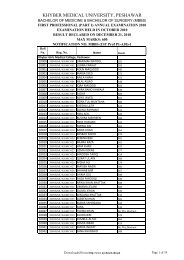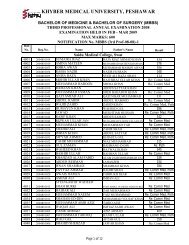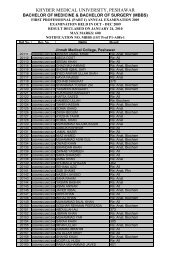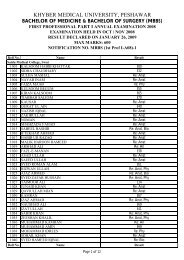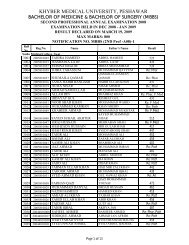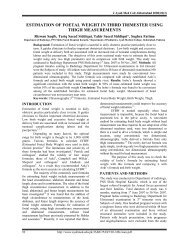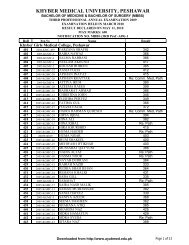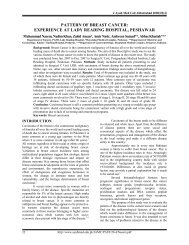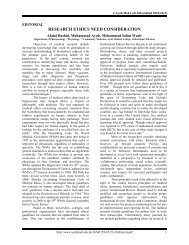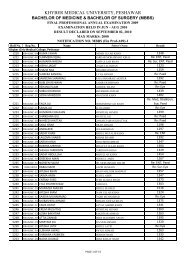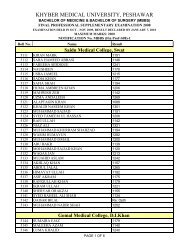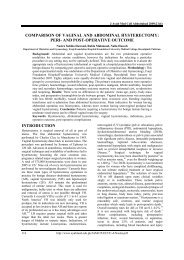LETTERS TO EDITOR Bing H. Tang, - Ayub Medical College
LETTERS TO EDITOR Bing H. Tang, - Ayub Medical College
LETTERS TO EDITOR Bing H. Tang, - Ayub Medical College
Create successful ePaper yourself
Turn your PDF publications into a flip-book with our unique Google optimized e-Paper software.
J <strong>Ayub</strong> Med Coll Abbottabad 2008;20(2)<br />
<strong>LETTERS</strong> <strong>TO</strong> EDI<strong>TO</strong>R<br />
<strong>Bing</strong> H. <strong>Tang</strong>,<br />
2 South 16 th Street, New Hyde Park<br />
N Y, 11040, USA<br />
Dear Editor,<br />
I read with interest and concern on one of the recent<br />
articles entitled ‘ANAESTHESIA FOR<br />
INTERVENTIONAL NEURORADIOLOGY’. (J<br />
<strong>Ayub</strong> Med Coll Abbottabad 2007;19(3):80–4). I am<br />
sincerely writing you as follows:<br />
We agree that ethical and practical issues<br />
hamper randomized trials in both invasive<br />
neuroradiology and neurosurgery; however, the<br />
crossover paradigm of a study design does not<br />
resolve these issues. The ethical and practical issue of<br />
how to properly deal with the control group in<br />
intervention studies, such as interventional<br />
neuroradiology, merits adequate consideration,<br />
especially for the anaesthesia medical group who<br />
have accepted and participated the task.<br />
Before any anaesthetics undertake, at least,<br />
in some clinical situations, it would be useful to<br />
design a clinical study where those randomized to the<br />
control group could cross over to the<br />
interventional group after some pre-defined period of<br />
time or after meeting some sort of reasonable<br />
endpoint. With respect to endpoints, there appear to<br />
have proper concepts involved. An ‘endpoint’ does<br />
not mean the ‘measure’ or ‘severity’ of diseases, at<br />
least to this author. There are indeed different end<br />
points in certain diseases, hence we ought to combine<br />
them and improve the informational content of<br />
categorical clinical trial end points.<br />
The amount of time and the endpoint would<br />
be needed to be tailored to the particular disease–<br />
intracranial aneurysms or malformations or<br />
both, regardless of whether in the radiology<br />
department or in the Operating Room.<br />
It appears to be important to specify a<br />
practical suggestion about how the crossover data<br />
would be analyzed properly in those interventions<br />
that the authors have reviewed or the cases in your<br />
<strong>Medical</strong> Centre. The primary analysis would have to<br />
be limited to the randomized patients, at least in your<br />
own data set of your <strong>Medical</strong> Centre. It also appears<br />
to be significant in knowing that the crossover data<br />
would potentially add information of estimates of<br />
radiological vs. surgical or medical (via medications),<br />
plus anaesthetic risk respectively or jointly in various<br />
combinations.<br />
That being discussed, in the case of a<br />
clinical trial on endovascular preventive treatment of<br />
unruptured intracranial arteriovenous malformation<br />
(AVM) or aneurysms, the ethical discussion is to be<br />
considered as follows. There is dubiousness of the<br />
clinical manifestation and prognosis. Prophylactic<br />
measures of unruptured intracranial AVM and<br />
aneurysms are frequently carried out. Nevertheless,<br />
measures in such an intervention have never been<br />
well recorded with contrast to those treated in the<br />
traditional method. In a background of doubtfulness,<br />
the so-called ‘best selection of treatments’ that can be<br />
supplied provided to each participant is merely odds<br />
in regard to an obvious protection from an AVM or<br />
aneurismal rupture that the participant (patient) may<br />
possibly obtain, regardless of whether or not the<br />
procedures are to be done in the radiological<br />
department.<br />
Thank you.<br />
<strong>Bing</strong> H. <strong>Tang</strong>, MPH (Columbia University), MD.<br />
Editor’s Note:<br />
The letter has been forwarded to author of the article and is also open to healthy discussion.<br />
148<br />
http://www.ayubmed.edu.pk/JAMC/Past/20-2/Letters.pdf
J <strong>Ayub</strong> Med Coll Abbottabad 2008;20(2)<br />
Jahangir A Khan,<br />
Chief Research Officer,<br />
Pakistan <strong>Medical</strong> Research Council,<br />
Islamabad.<br />
Dear Editor,<br />
Apropos to Prof. Dr. Tariq Mufti’s ‘A journey from<br />
member of editorial board to Chief Editor’. Though a<br />
nice chronological perspective by the out-going Chief<br />
Editor, Dr. Mufti, has been penned down but I feel<br />
there is something to add…<br />
I vividly remember that it was perhaps one<br />
of the coldest mornings of December of 1987 while<br />
sitting in my PMRC office and enjoying the drizzling<br />
of snow on my window pane that I was called by Dr.<br />
A. J. Khan, the founder Principal of <strong>Ayub</strong> <strong>Medical</strong><br />
<strong>College</strong>, in his office, which was only a few paces<br />
away to my office. I walked across to his office and<br />
saw Prof. Syed S. H. Zaidi and Dr. M. A. Khaliq<br />
sitting beside the electric heater trying to warm<br />
themselves while sipping hot cup of tea. Hardly sat in<br />
between them that a Naib Qasid put cup of tea in<br />
front. Dr. A. J. Khan, looked at me and promptly<br />
asked “can you start a medical journal for AMC?”<br />
after a pause I replied immediately “why not? Sir!”<br />
while looking with smile on my both sides who must<br />
have referred my name to Dr. A. J. Khan for the task.<br />
I had recently, returned from UK after my<br />
PhD and taken up the job as Principal Research<br />
Officer at PMRC Research Centre, AMC, the founder<br />
Centre in-charge. It was no doubt a challenging<br />
assignment having no experience in publication<br />
though published few research articles during my<br />
PhD studies at Queen’s University. I made a<br />
presentation on the format for JAMC to the AMC<br />
faculty and one out of six was well appreciated. The<br />
immediate task was to collect good articles from the<br />
medical comity of the country. The 1 st issue was<br />
published in 1988 and I was honoured to write first<br />
article for the first issue of JAMC.<br />
There was an overwhelm response to our<br />
first JAMC issue from within the country and abroad.<br />
My cold office started feeling warmth and became<br />
the centre for meetings in the coming days and we<br />
never looked back.<br />
It was the beginning of computer age and we<br />
were fortunate to have an XT computer at our PMRC<br />
Research Centre, which was utilized to its fullest<br />
capacity. The Centre was lucky to have Mr. M. Iqbal,<br />
stenographer, who quickly learned to format the<br />
JAMC. How can we forget services of Mr. M. Ajmal,<br />
who later became part and parcel of JAMC and is<br />
still working zealously and perhaps, would retire<br />
from JAMC office!<br />
The cold journey of JAMC started in the last<br />
century has been continuing into the new millennium<br />
and one can feel the warmth emanating from its<br />
pages. Being the first managing editor of JAMC I<br />
feel very proud and always wish that JAMC further<br />
attains the heights in the comity of medical journals<br />
in the world.<br />
May God bless all the members of the<br />
present Editorial Board with great success in future<br />
endeavours.<br />
Dr. Jahangir A. Khan<br />
Editor’s Note:<br />
Sir, How can we forget your services for the noble cause? The JAMC was, of course, planted and groomed by you<br />
and all of us have been pouring our efforts in to bring this up to the level of an indexed journal. We have now earned<br />
respect and confidence of our readers and contributors, not only from home but globally. After publication of online<br />
edition the JAMC has reached the most remote corners of the world and is, probably the most popular medical<br />
journal from Pakistan. All this has become true through the endless efforts of the whole team, no matter the<br />
individual names are remembered or not.<br />
http://www.ayubmed.edu.pk/JAMC/Past/20-2/Letters.pdf 149




